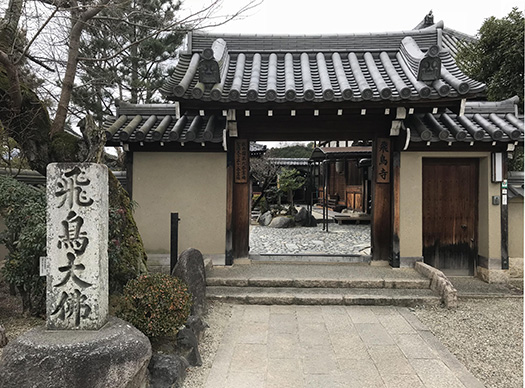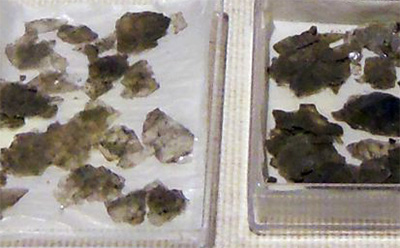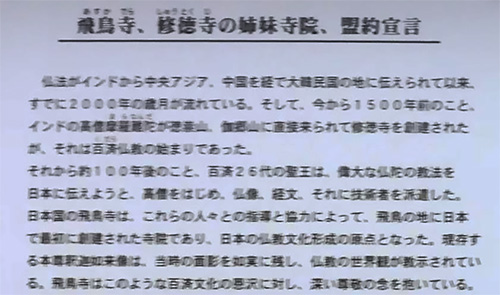


北海道に住んでいる歴史好きにはいても立ってもいられぬ好事の情報に接する。
作家・司馬遼太郎さんを育んだ産経新聞の歴史記事で
2021/10/11「蘇我馬子 創建の飛鳥寺から謎の雲母 埋納の装飾品か」
あ、有料会員用の記事なので一般のWEBからは参照できません。
「飛鳥時代に創建されたわが国初の本格寺院「飛鳥寺」=奈良県明日香村=の
創建時の塔心礎(塔の中心柱を受ける礎石)から雲母片が百点近く見つかった。
一緒に出土した刀子や鉄器、水晶玉などの遺物とは明らかに異なる鉱物の薄片。
それはどんな意味を持つのか。」という記事であります。
わたしはこの飛鳥寺参観の体験を2度ほど持っております。
この「飛鳥」周辺には石舞台とか、飛鳥坐神社とかの古代史スポットが満載。
現代時間よりもどっぷりと古の時空間を感じさせられ、
現代はその古代時間の脇役として時を刻んでいるような錯覚を覚える(笑)。
写真は上と下が飛鳥寺訪問時のわたしの撮影で中が産経記事の説明写真一部。
「雲母は出土当時は「細片数個」と報告されているが、報告後に
さらに確認されたり剝離があったのか現状は破片が96点で粉々になった細片も。
大きさは最大のもので2.6cm×2cm。〜」
「出土状況から心礎の上に立てられた心柱周囲に納められたものとみられる。
朝鮮半島などでは雲母を古墳や古代寺院に埋納した例がある」とのこと。
雲母というのは別名で「きらら」という日本名が知られるもの。
古代の宗教的建築ではこのような「祈り」をそれに込める物質が散布される。
イマドキの「地鎮祭」などでもコメを散布したり塩を撒いたりするけれど、
そういったおまじないに近い行為だったのでしょうね。
この飛鳥寺には飛鳥大仏という鞍作止利制作になる日本最古の仏像もある。
寺の説明文章が張られていたのを撮影したのが下の写真ですが、
韓国・百済の修徳寺(しゅうとくじ)と飛鳥寺の縁起が書かれています。
蘇我氏全盛の時代、仏教の日本社会への導入が国家意志として行われた。
そのシンボルとして百済の全面的バックアップを得て飛鳥寺は創建された。
いまになってもこういった新発見があり続けていることが新鮮。
またこのような歴史記事がときどき産経WEBには掲載される。
司馬遼太郎さんは作家デビューする前にはこのような歴史記事担当記者として
関西周辺を巡り歩いていたと書かれている。
そのよき伝統がいまも記事紙面に息づいているのだなぁと感じさせられる。
既成メディアに対してつい否定的な思いを持つことが多いのですが、
こういう地道な情報発掘姿勢というのはメディアの大切な役割だと実感。
しばし、悠久の時間感覚に浸らせていただいて感謝であります。
English version⬇
[Excavation of ancient mica “Kirara” at Asuka-dera Temple-Sankei history article]
Get information on good things that history lovers living in Hokkaido can’t stand.
In a historical article of the Sankei Shimbun that brought up the writer Ryotaro Shiba
2021/10/11 “Is it a mysterious mica buried ornament from Asuka-dera Temple founded by Soga no Umako?”
Oh, it’s an article for paid members, so you can’t refer to it from the general WEB.
“Asuka-dera, the first full-scale temple in Japan built during the Asuka period (Asuka-in) = Asuka Village, Nara Prefecture”
Nearly 100 pieces of mica were found in the cornerstone of the tower at the time of its construction (the cornerstone that receives the central pillar of the tower).
Mineral flakes that are clearly different from the relics such as swords, ironware, and crystal balls that were excavated together.
What does that mean? It is an article called.
I have had this experience of visiting Asuka-dera twice.
The area around this “Asuka” is full of ancient history spots such as the stone stage and Asukaniimasu Shrine.
It makes me feel a lot more old space-time than modern time,
Today, I get the illusion that time is ticking as a supporting role in that ancient time (laughs).
The top and bottom of the photo are taken by me when I visited Asuka-dera Temple, and the inside is a part of the explanation photo of the Sankei article.
“At the time of excavation, mica was reported to be” a few pieces “, but after the report
At present, there were some fragments that were shattered at 96 points, whether they were confirmed or separated.
The largest size is 2.6 cm x 2 cm. ~ ”
“From the excavation situation, it seems to be one of the things that were put around the pillar that was erected on the foundation.
It is said that there are examples of mica buried in ancient burial mounds and ancient temples on the Korean Peninsula. “.
Mica is another name for the Japanese name “Kirara”.
In ancient religious architecture, substances that put such “prayer” into it are sprayed.
Rice is sprinkled and salt is sprinkled at Imadoki’s “jichinsai” etc.
It must have been such a magical act.
At this Asuka-dera temple, there is also the oldest Buddha statue in Japan called Asuka Daibutsu, which was produced by Tori Busshi.
The photo below shows the explanation of the temple.
The luck of Sudeoksa Temple and Asuka Temple in Baekje, South Korea is written.
During the heyday of the Soga clan, the introduction of Buddhism into Japanese society was a national will.
Asuka-dera was built with the full backup of Baekje as its symbol.
It is fresh that such new discoveries continue to exist even now.
In addition, such historical articles are occasionally published in the Sankei Shimbun.
Ryotaro Shiba was a reporter in charge of such historical articles before his debut as a writer.
It is written that he was walking around the Kansai area.
It makes me feel that the good tradition is still alive in the article.
I often have negative feelings about ready-made media,
I realized that this kind of steady information excavation attitude is an important role of the media.
Thank you for letting me immerse myself in the eternal sense of time for a while.
Posted on 10月 14th, 2021 by 三木 奎吾
Filed under: 日本社会・文化研究, 歴史探訪







コメントを投稿
「※誹謗中傷や、悪意のある書き込み、営利目的などのコメントを防ぐために、投稿された全てのコメントは一時的に保留されますのでご了承ください。」
You must be logged in to post a comment.